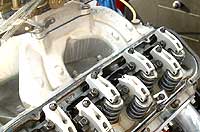|
My turn comes soon enough. I’m belted into my own single-seater
dragster and left with my thoughts while White, Hemmingson,
and Dooley make their own hot laps under Hill’s close
scrutiny. I realize it’s a serious place, the cockpit
of a racecar, where not only must I go over my engine start
procedure, remember to watch the gauges, and figure out how
the transbrake and reverser work, but I also can’t help
but think about my family, my wife and two-year-old son, and
trust that everything will go well and smoothly. And this
is “just” a tuned down Super Comp drag racing
school car! All those very serious helmeted expressions I
see in the staging lanes make that much more sense to me now.
Hill starts me out with a couple of burnouts and squirts
to the 60-foot marker. I have a little trouble getting into
reverse the first couple of times, but only because I didn’t
fully understand how the lockout mechanism worked. I also
have to admit I stalled a couple of times after not bringing
the RPMs up enough for the launch, but after that it was off
to the races, quite literally, and from the seat of my pants
it felt like I was Larry Dixon, boiling the hides with the
rear end kicking out from beneath me. Unfortunately, photographic
evidence later proved only a couple of minor puffs of smoke
and the rear slicks never strayed more than a few inches from
following the fronts. Oh well, it still felt good at the time.
Then it’s time for my first full pass. NHRA rules apparently
limit first timers to eighth-mile passes on their first day
anyway, so this is what I came for. I’m feeling the
pressure, and all I’m trying to do is make sure everything
goes as planned and Hill stays happy. Again, I can only imagine
what it’s like for real drivers when they’re racing
for the win or big money, a points chase hangs in the balance,
or maybe even their ride or career is on the line.
Hill gives me the go-ahead to go for it, so I do. The car
leaves hard, it’s tracking smooth, it shifts to high
gear, and BWAAAAAAAAAAAA, BRAP-BRAP-BRAP-BRAP … something’s
wrong. The engine note changes drastically so I let off and
kill the ignition. All day, Hill stresses over and over, “If
something happens that you’re not prepared for, shut
it off. If you don’t know what’s going on, shut
it off. If you’re in doubt, shut it off.” Well,
this qualifies on all three counts, so I shut it off and the
next thing I hear over the radio is: “What’d you
let off for?! It was on a good pass!”
Not being able to answer back, all I can do is coast to a
stop at the far end, pull off my helmet, climb out of the
car, and wait for the crew to show up while I contemplate
what might have been. This is one part of the racer’s
experience I really wasn’t looking for.

The parts breakage that taught
me what it’s like to sit at the quiet end of a dragstrip
and wonder if my day was prematurely over. |
Eventually, with help from James McDunnah, Hill’s do-everything
assistant, we get the car back to the pits where Hill wants
to hear the engine for himself. BRAP-BRAP-BRAP-BRAP …
“Broken rocker arm,” he says. McDunnah pulls the
valve cover off the right bank and there it is: a broken rocker
arm. “You done the right thing,” Hill tells me.
Half an hour later with a new rocker in place we fire the
engine back up and it sounds every bit as good as it did when
we started. Hill tells me to get back in the car and be prepared
to make back-to-back passes, as we’re going to lose
the daylight shortly.
I’m feeling more comfortable in the car by now, learning
where all the switches are by memory, realizing its turning
radius, and just generally getting a better feel for what
it does. Hill lines me up in the right lane, my burnout goes
well, I stage, and go! First gear, second gear, it’s
still pulling, and I go through the traps in 5.852 seconds
at 123.55 mph.
Here’s what I was working up to
all day: 5.856 at 123.81 mph. Many have gone quicker, but none
have had more fun!
With no time to waste I hustle back to the starting line.
“How’d you like that?” Hill asks over the
radio. “It’s better than sex, isn’t it?”
Again he puts me in the right lane, I go through the preliminaries,
and blast to a 5.856-seconds pass at 123.81 mph. My reaction
times aren’t going to intimidate anyone, a .405 and
a .319, but you can’t fault that bracket-like consistency
(I know, I know, it’s the car).
The point is, I had driven a real racecar and it did feel
pretty darn good. To be honest, I felt alive and lucky to
be doing what I was doing. And I do think I gained a little
more insight into the racer’s world. That, and my all-important
T-shirt. After all, I earned it by surviving the self-proclaimed
“Drill Sergeant of Drag Racing” and I’d
do it again in a heartbeat.
| SOURCE:
Roy Hill’s Drag Racing School
4926 Walker Mill Road
Sophia, North Carolina 27350
|
Phone (336) 498-7964
Fax (336) 498-8706
Email: info@royhillsdragracingschool.com |

|

